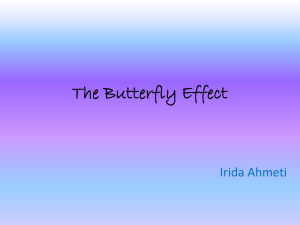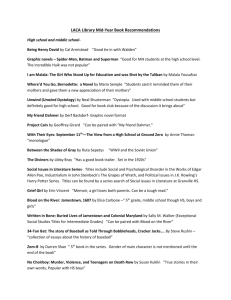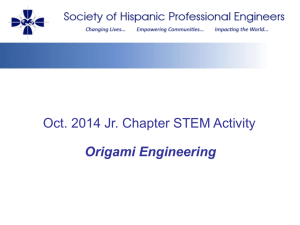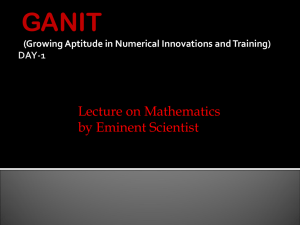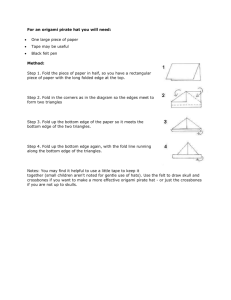Guidelines for an OSME Proposal Introduction The OSME meetings
advertisement
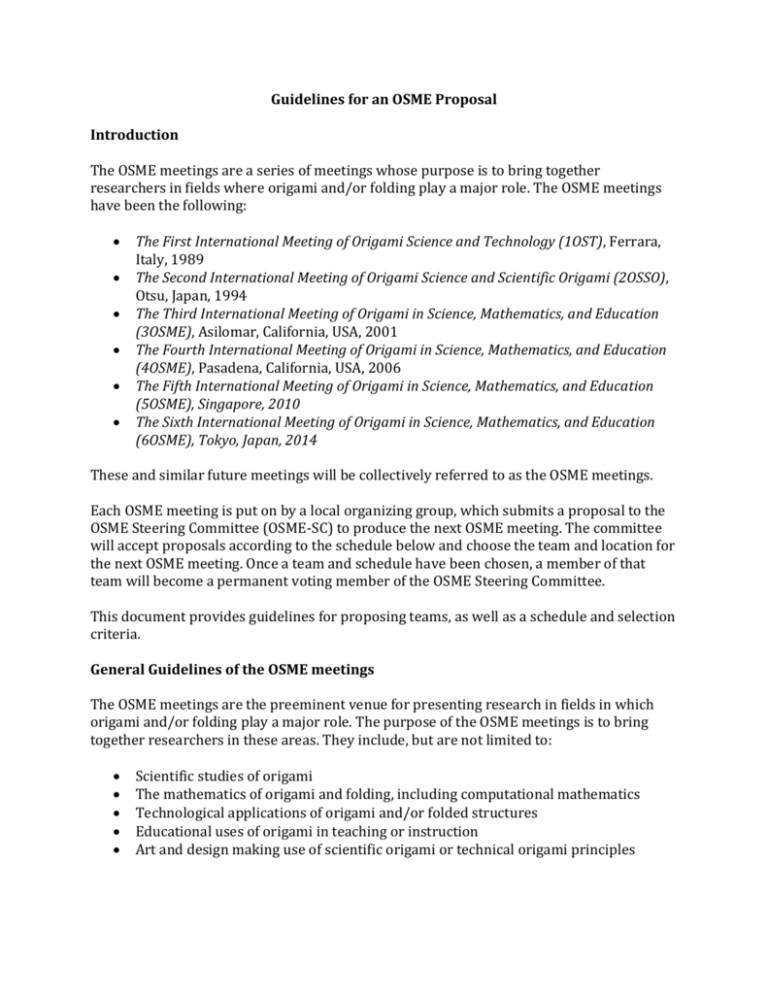
Guidelines for an OSME Proposal Introduction The OSME meetings are a series of meetings whose purpose is to bring together researchers in fields where origami and/or folding play a major role. The OSME meetings have been the following: The First International Meeting of Origami Science and Technology (1OST), Ferrara, Italy, 1989 The Second International Meeting of Origami Science and Scientific Origami (2OSSO), Otsu, Japan, 1994 The Third International Meeting of Origami in Science, Mathematics, and Education (3OSME), Asilomar, California, USA, 2001 The Fourth International Meeting of Origami in Science, Mathematics, and Education (4OSME), Pasadena, California, USA, 2006 The Fifth International Meeting of Origami in Science, Mathematics, and Education (5OSME), Singapore, 2010 The Sixth International Meeting of Origami in Science, Mathematics, and Education (6OSME), Tokyo, Japan, 2014 These and similar future meetings will be collectively referred to as the OSME meetings. Each OSME meeting is put on by a local organizing group, which submits a proposal to the OSME Steering Committee (OSME-SC) to produce the next OSME meeting. The committee will accept proposals according to the schedule below and choose the team and location for the next OSME meeting. Once a team and schedule have been chosen, a member of that team will become a permanent voting member of the OSME Steering Committee. This document provides guidelines for proposing teams, as well as a schedule and selection criteria. General Guidelines of the OSME meetings The OSME meetings are the preeminent venue for presenting research in fields in which origami and/or folding play a major role. The purpose of the OSME meetings is to bring together researchers in these areas. They include, but are not limited to: Scientific studies of origami The mathematics of origami and folding, including computational mathematics Technological applications of origami and/or folded structures Educational uses of origami in teaching or instruction Art and design making use of scientific origami or technical origami principles This is not a complete list, and future OSME organizers may expand or modify this list. However, the scope of an OSME meeting does not include origami instructional presentations, except as an incidental part of a presentation. Presentations should be of a type, quality, and style that would be found at a professional meeting in the origami-related field, e.g., an origami-math presentation at an OSME would be structured like a presentation at a professional mathematics conference. It is allowed, even encouraged, to hold an instructional origami convention in close proximity to an OSME meeting (as was done in 2010 with 5OSME+ and 2014 with the Origami Tanteidan 20th convention) to increase attendance. However, the distinction between the two events should be made clear. OrigamiN book: It is expected that each OSME meeting will produce a book of peerreviewed papers based on the conference presentations. The name is strongly suggested to follow the format OrigamiN, where N is the number of the meeting. The OSME meetings should be held every 4 years. It is anticipated that there may be other meetings on OSME-related topics in the intervening years organized by origami groups and/or non-origami professional societies (e.g., NCTM, MAA, ASME…), but such meetings should not use the OSME name or one close to it. A local group organizes the OSME meeting under the general guidance of the OSME-SC. Most of the organizational work is to be carried out by the local group. The local organizing group is responsible for all of the financial activities and profit/loss. Next OSME meeting The next OSME meeting will be titled The Seventh International Meeting of Origami in Science, Mathematics, and Education (7OSME). 7OSME should be held in calendar year 2018. The exact date may be chosen by the proposing team to accommodate local venue availability and conditions. Late summer and early fall are strongly recommended to accommodate academic schedules. Schedule of Proposal Proposers should send a written proposal to the OSME Steering Commitee, at 7osmeproposal@osme.info, prior to 31 December 2014. The OSME-SC will evaluate all proposals received by that time and, if necessary, follow up individually with the proposers. The OSME-SC will choose the team to present the next OSME meeting by 28 February 2015. After confirmation from the selected team, the date, location, and organizing team will be announced on the OSME website and through major origami and professional organizations. Elements of an OSME An OSME meeting is a professional meeting, similar to those put on by professional societies and groups and attended by students, professors, and professionals in their field. The primary activity of an OSME meeting is technical presentations, but there are also typically other activities that are part of the overall schedule of activities. Duration Past OSMEs have typically run 3 full days for the technical program. This is not a strict requirement, but is suggested. Technical Presentations There should be rooms with seating and projection for technical presentations. The number of presentations has increased steadily over the years; at 6OSME there were 128 technical presentations. There should be sufficient rooms and projection to accommodate a somewhat higher number, assuming that the growth continues. Presentations should be 15-20 minutes with time for questions. Parallel sessions are allowed. 6OSME had 4 parallel sessions. Organizers should group papers by topic so that people interested in a topic don’t have to jump back and forth between sessions. There should be a session chair for each session to introduce the speaker and to monitor the time. Past OSMEs have striven to be high-quality professional conferences where scientists, mathematicians, and educators can share their work and all participants can be inspired by the work of others. Future OSMEs should meet or exceed this standard. To this end, every submitted abstract should be reviewed by at least two individuals with appropriate technical backgrounds, and the acceptance standard should be at least as stringent as for professional conferences in the origami-related field. Art and design submissions should be reviewed keeping in mind the scientific and technical thrust of the meeting. Depending on the quantity and quality of submissions, organizers should consider alternate formats for sharing ideas in addition to regular talks, for example poster sessions, swap sessions, mini-presentations with longer Q&A, etc., as appropriate to the particular submissions for a given OSME. In the past, there have not been post-deadline papers, but there has been considerable interest in providing a way that exceptional late-breaking work could be added to the program. Plenary Speaker It is common to have one or more invited Plenary speakers to give a keynote speech attended by all participants. The Plenary speaker should be someone highly respected or somehow exceptional in the field. It is standard to pay travel costs for the plenary speaker(s) and to waive their registration fee. Housing Housing should be available. Best is if housing is available at the presentation venue (e.g., if the venue is a hotel) and registration for housing can take place at the same time as the meeting registration. Next best would be to have separate hotel registration. Housing should be nearby, ideally, within walking distance. If the primary accommodation is hotel, it is desirable to have a range of price options available to accommodate both professionals with travel support, students living on a shoestring, and everyone in between. Meals It is desirable to provide meals at the venue or nearby, to avoid people having to leave and come back and/or insert large time slots for meal breaks. Box lunches are convenient. Keep in mind that conference participants will have various dietary restrictions (e. g. vegetarian, gluten-free, pork-free, kosher) and be sure to communicate clearly about which dietary restrictions can be accommodated. Drink/snack breaks in between sessions are desirable as well. Banquet/Reception It is desirable to have some combination of an opening reception; a conference banquet; and/or a closing reception. Special event Special events are allowed, e.g., side trips or excursions to local places of interest. Special events should not significantly cut into the time allotted to technical presentations. Poster Presentations Poster presentations may be supported at the discretion of the organizing team. Exhibition There may be, at the discretion of the organizing team, space for display of technical artifacts, and/or booths for sponsoring organizations to set up a display. Sponsors The organizing team is allowed (encouraged) to obtain sponsorship from businesses, individuals, civic organizations, or other groups. Discreet display of sponsor logos may be used at the event, on bags, etc. Logo/advertising The organizing team is allowed to choose its own logo for the event. The only requirement is that the name “7OSME” (or full event, spelled out) be used within the logo. Infrastructure for registration There should be provision for online registration for attendees. The vast majority of participants will be comfortable with online registration, however, if postal registration can be accommodated, that is a plus. Infrastructure for paper submission Papers should be submitted, tracked, and peer-reviewed through an online submission process. The EasyChair submission system (easychair.org) is a popular conference management system and was used for 6OSME. Pre- and post-meeting activities The organizing team may wish to organize excursions before or after the event, and/or to hold it in conjunction with some other event, e.g., a traditional instructional-focused origami meeting, or a closely related professional meeting in the same locale. On-site support There should be a “Help Desk” staffed at all times on site to deal with unexpected issues. Local requirements Are there unique local requirements? For example, venues in the U.S. must comply with the Americans with Disabilities Act. Schedule The suggestion schedule for major milestones of the event, in reverse chronological order, is: T T-2 weeks OSME meeting final program T-2 months T-3 months T-5 months T-6 months T-9 months T-12 months publication of accepted presentations deadline for published abstracts of presentations decision on accepted presentations early registration opens deadline for submissions call for papers The schedule for written submissions for the OrigamiN book may be adjusted to accommodate publisher contractual requirements and/or production issues. However, the sooner after the conference that the book can appear, the better. However, it is preferable to have the deadline for paper submissions to be shortly after the conference, so that authors can incorporate knowledge learned during the conference into their paper. Budget and finances The costs of organization will be borne entirely by the organizing team (who also get to keep any profit). Proposers should provide an estimated budget for the event. Preparation of a proposal An organizing team wishing to put on the next OSME team should prepare a proposal describing their plan. It should be responsive to all of the topics above and to the selection criteria listed below. We recognize that not all information may be available at the time of proposal; for example, it may not be possible to obtain venue budget information before getting a commitment from the committee or to get a commitment from the venue far in advance of the date. This is understandable; we request only that the proposers attempt to include as much information as is possible and available. Selection Criteria and Process Selection of the team and venue for the next OSME meeting will be done by the OSME-SC. Factors to be considered (in no particular order) are: Date of the event. Many participants are academics, and summer and/or traditional vacation times are preferable to maximize travel availability. Conversely, conflicts with existing known events of a similar nature are to be avoided. Organizational plans. How complete is the organizational plan? Does it address all of the areas outlined above? Size and experience of the organizing team. Prior experience organizing a professional meeting will be favored. Quality of the venue. Does the venue offer sufficient meeting rooms and projectors? Quality of housing. Is housing included? Is it on-site or near the venue? Are there alternatives for budget-constrained visitors? Proposed budget. Is the budget reasonable and plausible? Travel desirability of the venue. Venues in locations that are attractive places to travel to are desirable; when researchers are prioritizing their travel, we would like the desirability of the OSME locale to tip the balance in favor of our event over others. Desirability includes things like opportunities for side trips, tourist activities in the area, activities for accompanying spouses, and cost of travel to the venue. For which visitor countries will a visa be required? Cost of attendance. This includes not only travel costs, but housing, and any other costs that attendees are likely to bear. Geographic diversity. Is the venue in a region different from prior meeting(s)? Is the venue likely to bring in new-to-OSME participants because of its location? Any other factors. Are the additional factors that make this particular time, place, venue, particularly appealing, that are not addressed by the above?



